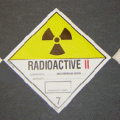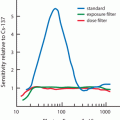Fig. 11.1
Basic components of a computer
The signals, i.e., electrical pulses from a scintillation camera, are obtained in analog form and are digitized by the digital computers for further processing and storage. Digital computers operate with binary numbers using only two digits, 0 and 1, as opposed to 10 digits 0–9 in the decimal system. The basic unit of the binary system is a bit (binary digit) that is either 0 or 1. The binary numbers are expressed by placing 0’s and 1’s in a row, e.g., 10101, which are equal to a sum of a series of powers of two, as opposed to decimal numbers that are expressed in powers of 10. Thus, the binary number 10101 (1 × 24 + 0 × 23 + 1 × 22 + 0 × 21 + 1 × 20) is equal to the decimal number 21, which is given as 2 × 101 + 1 × 100 in the decimal system.
The bits, 1 and 0, are represented by the “on” or “off” states of many transistor components present in the computer memory . A two-bit number can be expressed in 22, or four, ways (00, 01, 10, 11) corresponding to decimal numbers, 0, 1, 2, 3; a three-bit number can be expressed in 23, or eight, ways (000, 001, 010, 011, 100, 101, 110, 111) corresponding to decimal numbers 0, 1, 2,…7, and an n-bit number can be expressed in 2 n ways corresponding to decimal numbers from 0 to 2n − 1. In computer nomenclature, a byte of memory is equal to eight bits that can store up to 28, i.e., 0–255, units of information. Similarly, a word of memory consists of 16 bits or two bytes and can store up to 216, i.e., 0–65,535, units of information. In newer computers, a word can consist of 32 or 64 bits, allowing more counts to be stored in memory.
Central Processing Unit
The CPU, also called the microprocessor, performs all control, logic, and arithmetic operations in a computer. A computer program is a set of sequential instructions for the computer to perform with essential data inserted whenever appropriate. The CPU retrieves the instructions and data from memory storage, executes the instructions sequentially, and displays or stores the results in appropriate locations. Transfer of data from one location to another is performed by the CPU using buses, which are essentially a set of electrical connections.
How fast a program is executed depends on the speed of the computer operation, which increases with the faster electrical components of the CPU. The efficiency of the computer operation is further increased by using parallel transfer of data (where many transfers are performed simultaneously) rather than serial transfer (where only one transfer is carried out at a time).
Computer Memory
The memory of a computer is a section assigned for temporary storage of data during the operation of a program. The program instructions and processed data are all stored in the computer memory with the help of the CPU. When the CPU sends data to the memory, it writes the data into the memory. If the CPU retrieves data from the memory, it is then said to read the data from the memory. The memory can be of two types: random access memory (RAM) and read-only memory (ROM). RAM has the advantage of both write and read capacity; however, the data stored in it is lost when the computer is shutoff or the electrical power is lost. With larger RAMs, computation time becomes shorter. On the other hand, data stored in ROMs such as CD-ROMs, DVD-ROMs, etc. cannot be erased by electrical failure or computer shutoff.
External Storage Devices
Floppy disks, hard disk drives, CD-ROMs, DVD-ROMs, magnetic tapes, and optical (laser) disks are varieties of external storage devices that are commonly used for storage of programs and data. Each of them has variable storage space. Hard drives are installed virtually in all computers for internal storage of the programs and data. Floppy disks are commonly used for storing data externally as backup copies, although in some applications programs and data can be stored for input into the computer for execution. While internal or external hard drives have the storage capacity of hundreds of gigabytes, floppy disks can only store up to a few megabytes and are getting out of use. Currently, CD-ROMs are available with capacities of 650–700 MB and DVD-ROMs with 4.7–9 GB. Magnetic tapes and laser optical disks have large storage space in compact form and can be utilized primarily for archiving of patient data that can be retrieved for future reference.
Input/Output Devices
Input/output (I/O) devices are essential for input of the initial data and for output of the processed data. Input and output of data are carried out by the use of acquisition and video interfaces via serial or parallel buses. The keyboard and the mouse are the most common input devices used in computers, although joysticks, light pens, and trackballs are occasionally used as input devices. While the keyboard is essential for the input of alphanumeric data such as patient identification, date, time, and operator’s name, the mouse and trackballs are used to select items from the menu. Light pens, a mouse, and touch screens are often used for the selection of regions of interest (ROI) in an image.
Common output devices include display screens (video monitor) for texts, images or graphics, and printers for printing. Display screens normally have a capability of a gray scale or a color scale for comparison between the intensities or amplitudes of different regions of the image.
Operation of a Computer
A computer operates according to instructions provided by an operator. These instructions are given in the form of one or more programs. A collection of programs is called the software , which is developed by specialists according to the specific need for a project. The most essential program for the operation of a computer is the so-called operating system (OS) such as Windows, Unix, and Linux. The utility of the OS is to facilitate communication between the computer and operator’s instructions. The operating system transfers the program instructions from the input device to the memory, commands the CPU to carry out the specific instruction and returns the data to the output devices. Other utilities of this system include file transfer from one location to another, storing data in the external storage device, and display of the data.
Data must be provided as input to the computer for processing, and in nuclear medicine they are available in the form of counts or voltage pulses obtained from scintigraphic studies. Data are processed according to instructions in the software program, and the processed data are then stored in computer memory or external storage spaces or displayed on video monitors. The time to complete a task by the computer depends on a number of factors such as the speed of the CPU, the size of the RAM, serial or parallel processing of data, and the data transfer rates of the I/O devices. The faster CPU, the larger size of RAM and the parallel buses provide speedy computation.
Digitization of Analog Data
In nuclear medicine, signals from a gamma camera are acquired in analog form, which are digitized before storing and further processing by the computer. Conversion of analog signals to discrete digital values is performed by the so-called analog-to-digital converters (ADCs) and the process is called digitization.
While analog signals are continuous in time, digital signals consist of a fixed number of bits produced by the ADC by sampling a selected number of time points in the analog signal. ADCs are available as 8-, 10-, 12-, or 16-bit depending on the number of bits they produce in the digital signal from the analog signal. While the analog signals can be distorted by the electronic noise, there is some inherent loss of signal information as a result of digitization, i.e., due to different time-point selections during the analog-to-digital conversion . This arises from the fact that there is a likelihood of a small fraction of the signal being lost during the conversion of a continuous analog signal to discrete digital values. However, higher bit ADCs minimize this loss by producing a large number of bits from each analog signal. The faster ADCs can handle higher count rates. The slower ADCs increase the dead time of the system and hence are good for low count rates only.
Digital-to-Analog Conversion
For video displays, data must be in the analog form, and therefore digitized data must be converted back to analog data. This is performed by units, called the digital-to-analog converters (DACs), similar to the ADCs. DACs are connected to the computer via video interface cards, and the speed of digital-to-analog conversion depends on the speed of various electrical components included in its operation.
Digital Images
Digital images are characterized by two quantities: matrix size and pixel depth. The computer memory approximates the area of the detector in a gamma camera as a square matrix of a definite size that can range from 32 × 32 to 1024 × 1024 with 1024 (1 K) to 1,048,576 (1 M) picture elements, called pixels , respectively. The size of a matrix is selected by the operator, depending on the type of task to be performed and is approximated to the field of view (FOV). Each pixel corresponds to a specific location in the detector. As discussed in Chap. 9, the X– and Y-pulses are obtained in the analog form from the photomultiplier (PM) tube, which originate from the interaction of γ-rays in the detector. The X– and Y-analog pulses are digitized by the ADC and stored in the appropriate pixel of the matrix. How many counts can be stored in a pixel depends on the depth of the pixel, which is represented by a byte or a word . Thus, a 1-byte pixel could record up to 28, or 256, events, whereas a 1-word pixel could store up to 216, or 65,536, events.
The pixel size, which depends on the choice of the matrix size for a study, is an important factor that affects the spatial resolution of a digital image. The field of view is approximated to the matrix size; therefore the pixel size is calculated by dividing the FOV by the number of pixels across the matrix. Thus if an image of 250 × 250 mm FOV is obtained in a matrix of 128 × 128 mm, the pixel size would be 250/128 ≈ 2 mm. If the matrix size is changed to 64 × 64, then the pixel size would be ~4 mm. Often, a zoom factor is applied during data acquisition to improve spatial resolution because it reduces the pixel size. Overall, the pixel size d can be calculated as

(11.1)
where z is the zoom factor (1.2, 2.0, etc.,) and N is the number of pixels across the matrix. The use of a zoom factor of, say, 2, reduces the pixel size by half, improving the spatial resolution, but counts per pixel are reduced thus increasing the noise on the image (see later).
The choice of pixel size and zoom factor is limited by the spatial resolution of the imaging device, particularly in tomographic systems. Ideally, the pixel size should be less than 1/3 of the expected spatial resolution of the SPECT system , measured at the center of rotation. That is,






